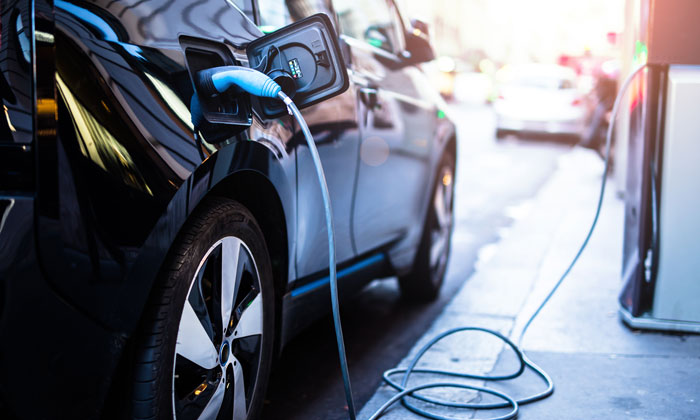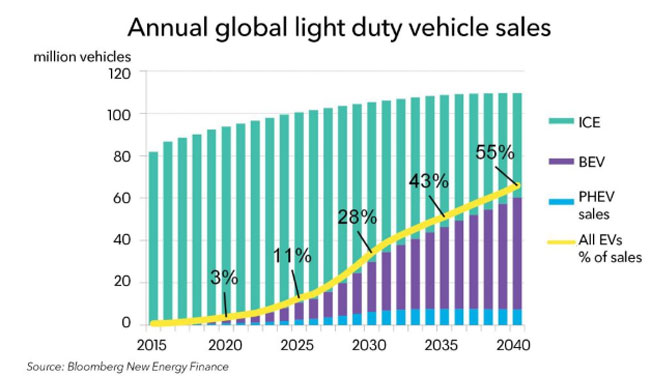Thirty million electric vehicles predicted to be sold by 2030
- Like
- Digg
- Del
- Tumblr
- VKontakte
- Buffer
- Love This
- Odnoklassniki
- Meneame
- Blogger
- Amazon
- Yahoo Mail
- Gmail
- AOL
- Newsvine
- HackerNews
- Evernote
- MySpace
- Mail.ru
- Viadeo
- Line
- Comments
- Yummly
- SMS
- Viber
- Telegram
- Subscribe
- Skype
- Facebook Messenger
- Kakao
- LiveJournal
- Yammer
- Edgar
- Fintel
- Mix
- Instapaper
- Copy Link
Posted: 25 May 2018 | Intelligent Transport | No comments yet
The increase in electric vehicle sales will be influenced by how quickly charging infrastructure spreads across key markets and by the growth of ‘shared mobility’…


The electrification of road transport is expected to rapidly increase in the second half of the 2020s, due to falling battery costs and larger-scale manufacturing, with sales of electric cars reaching 28 per cent, and electric bus sales 84 per cent, of their respective global markets by 2030.
The latest long-term forecast from Bloomberg New Energy Finance (BNEF) shows sales of electric vehicles (EVs), increasing from the record 1.1 million worldwide in 2017 to 11 million in 2025, and then surging to 30 million in 2030 as they establish cost advantage over internal combustion engine (ICE) cars.
China is predicted to lead this transition, with sales there accounting for almost 50 per cent of the global EV market in 2025 and 39 per cent in 2030.
The number of ICE vehicles sold per year (gasoline or diesel) is expected to begin declining in the mid-2020s, as EVs enter their market with strength. In 2040, approximately 60 million EVs are projected to be sold. ‘Shared mobility’ cars will be a small but growing element.


The advance of e-buses will be even more rapid than electric cars, according to BNEF’s analysis. It illustrates electric buses in almost all charging configurations having a lower total cost of ownership than conventional municipal buses by 2019. Electric models are on track to dominate the global market by the late 2020s.
Colin McKerracher, Lead Analyst on advanced transportation for BNEF, commented: “Developments over the last 12 months, such as manufacturers’ plans for model roll-outs and new regulations on urban pollution, have bolstered our bullish view of the prospects for EVs. The changes to our forecast this time compared to the previous one a year ago are modest, at least as far as cars are concerned. We now think EVs will be 55 per cent of light-duty vehicle sales in 2040 and represent 33 per cent of the total car fleet worldwide.
“But the big new feature of this forecast is electric buses. China has led this market in spectacular style, accounting for 99 per cent of the world total in 2017. The rest of the world will follow and by 2040 we expect 80 per cent of the global municipal bus fleet to be electric.”
BNEF expects the transition in transport to have major implications for electricity demand, and for the oil market. EVs and e-buses will use 2,000TWh in 2040, adding six per cent to global electricity demand. Meanwhile, the switch from ICE to electric vehicles is forecast to displace 7.3 million barrels a day of transport fuel.
Salim Morsy, Senior Transportation Analyst, said: “While we’re optimistic on EV demand over the coming years, we see two important hurdles emerging. In the short term, we see a risk of cobalt shortages in the early 2020s that could slow down some of the rapid battery cost declines we have seen recently. Looking further out, charging infrastructure is still a challenge.”
The pace of electrification in transport will vary by country, particularly over the next 12 years as some markets jump ahead of others. BNEF forecasts that in 2030, EVs will make up 44 per cent of European light-duty vehicle sales, 41 per cent of those in China, 34 per cent in the U.S. and 17 per cent in Japan. However, a shortage of charging infrastructure and a lack of affordable models will hold back the market in India, meaning EVs will make up just seven per cent of new car sales in 2030 there.
Related organisations
Bloomberg New Energy Finance
Related people
Colin McKerracher, Salim Morsy








